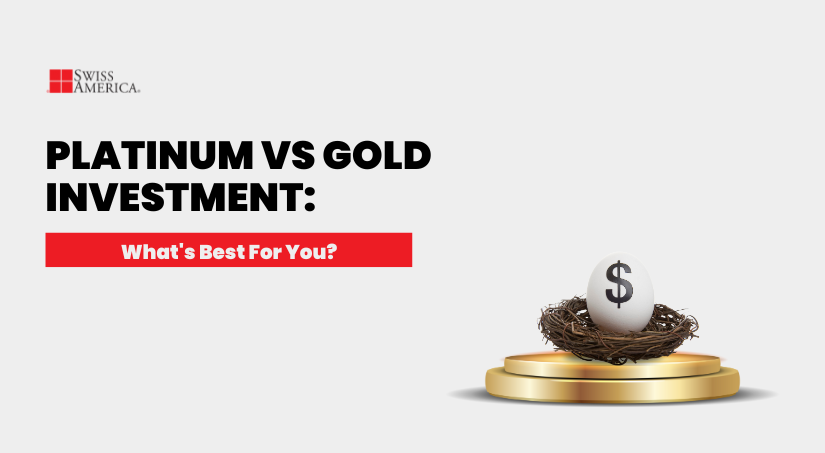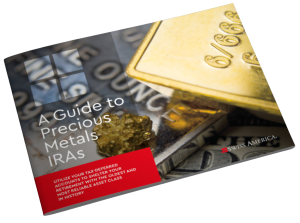
If you’re trying to decide between a platinum vs gold investment, what factors should you consider? Is one better than the other? Learn about the differences so you can decide which makes the most sense for you.
People usually consider gold a safe-haven asset, but some investors see platinum as a way to get potentially higher returns. We’ll cover the differences between the two so you can decide which metal (or both!) to add to your portfolio.
Either physical metal gives you a tangible asset, a way to diversify your portfolio and an investment that you can completely control.
Gold vs platinum: key differences
When you’re trying to decide between these two precious metals, it’s helpful to understand their fundamentals, which make each unique. These include:
Physical properties
Industrial uses
Market size
Price behavior
Physical properties
Gold and platinum have different physical characteristics, including:
Density: Platinum is denser than gold (21.5 g/cm³ vs 19.3 g/cm³).
Malleability: Gold is more malleable, allowing for easier shaping.
Rarity: Platinum is about 30 times rarer than gold in the Earth’s crust.
These properties influence the metals’ uses and perceived value. That’s why platinum’s rarity seems odd to investors, who would expect it to have a higher price point.
Industrial uses
The applications of both precious metals extend beyond jewelry and the investment sector:
Gold
Electronics: Connectors and switch contacts.
Dentistry: Fillings and crowns.
Aerospace: Astronaut helmets and satellite components.
Platinum
Automotive: Catalytic converters.
Chemical industry: As a catalyst in various processes.
Medical field: Pacemakers and cancer treatments.
Platinum’s commercial demand makes its price more sensitive to economic cycles than gold. So, you’ll need to evaluate the economic situation and platinum’s patterns to see if the timing is right to invest in it.
Market size
Gold has the largest market share in the industry compared to other precious metals. The physical financial gold market is worth around $5 trillion. And, annual gold production is about 3,000 metric tons, while platinum is around 190 tons.
This market size difference impacts liquidity and since gold has a larger market, it’s easier to sell.
Price history and volatility
Looking at historical track records, gold and platinum tend to have distinct price trends and volatility patterns. If you look at gold’s price changes during different periods, you’ll notice they’re often less extreme. This makes it a reliable store of wealth in the long term.
Platinum is more volatile since its prices vary according to commercial demand. These price swings during economic cycles offer opportunities for higher returns but come with increased risk.
Since the 1970s, gold has shown a long-term upward trend, with significant price spikes during periods of economic crisis and uncertainty. The metals price trends during notable events in the past 30-50 years include:
1970s stagflation era: Gold prices soared from $35 per ounce to $850 by 1980, while platinum prices went from $230 to around $960 per ounce.
2008 financial crisis: This triggered another major gold rally, with prices reaching a then-record high of $1,900 per ounce in 2011. Platinum peaked at over $2,200 per ounce in 2008, briefly surpassing gold before dropping to about $800 by December of the same year.
COVID-19 Pandemic: Gold reached new record highs, surpassing $2,000 per ounce in 2020, while platinum saw significant fluctuations between lows of $600 to highs of slightly above $1000 per ounce.
The sharp rise and decline of platinum prices during the 2008 financial crisis gives you an idea of its high volatility and sensitivity to economic downturns. Since then, platinum has struggled to regain its pre-crisis highs, with prices varying between $800 and $1,500 per ounce in recent years.
Understanding these historical trends and the factors driving them can help you see where each metal fits in your portfolio. Gold stands out for its ability to preserve wealth over long periods and during crises. Platinum has a higher risk/reward.
Market dynamics
Some of the components that impact performance include:
Supply
Gold comes from mining production and recycling. And, annual global gold production averages around 3,000 tons. Major producing countries include:
China
Australia
Russia
Canada
United States
Platinum is a whole different game. About 70% of it comes from South Africa, with Russia and Zimbabwe close second mining countries. Since fewer countries mine platinum, if something goes wrong in any of these regions, it can impact supply and platinum’s price. The annual production is around 190 tons which is also much lower than gold.
Demand
Primary drivers behind the demand for these metals include:
Gold
Anytime there is a crisis, people turn to gold. It could be an economic downturn, a weaker U.S. dollar, or tensions between other countries. All of these situations increase the demand and make it valuable. Many investors buy gold to diversify their portfolios and help spread out risk in case any of these chaotic events happen.
In the Reddit r/Investing forum, user Agling shared their thoughts on the differences of investing in gold:
“People think of gold as a money substitute so it will always be liquid. Silver used to be that was but is less so now. Platinum has never been viewed as a money asset. It’s an industrial and jewelry commodity. So the retail market for it as bullion is not well developed. Same with palladium.”
Platinum
The bigger driver of platinum demand is industrial uses. Government regulation around emissions standards could increase the need for platinum in catalytic converters which would drive up prices. Or, if more people buy electric vehicles, this could decrease demand and in turn platinum price.
Central banks
Central banks have a large impact on the gold market but a very minimal impact on platinum. These organizations use gold to diversify reserves and reduce their country’s reliance on the U.S. dollar. When they buy or sell a lot of gold it can shake up the prices.
As of this writing, gold is about $2700/ounce and one of the drivers is that central banks are buying record amounts of gold. We’ve also recently discussed on our podcast how gold may soon hit as high as $3000/ounce:
Current market data and price trends
The price differential between platinum and gold has widened considerably in recent years. Gold is up more than 30% over the past year.
Platinum is a different story. It’s about $1,000 per ounce which is lower than January spot prices. The World Platinum Investment Council showed a platinum deficit of about 1 million ounces in 2024. So it could be a good time to buy if you believe that demand will continue.
Ways invest in gold and platinum
The most direct and reliable way to invest is to own physical gold or platinum. You can also buy paper assets like Exchange Traded Funds (ETFs) or precious metal stocks in mining companies.
Physical bullion
You can buy both metals in bars or coins. The right choice for you depends on how much you have to invest and your storage plans. If you’re investing a larger amount, bars are better option because they’re easier to store. But if you want portability, coins are easier to carry and sell in any country around the world.
To buy metal, you can use regular funds or money in your retirement accounts. If you want to use retirement funds, you’ll roll over a portion of your 401(k) or convert an existing IRA to a Gold or Precious Metals IRA.
Just note that retirement accounts have rules around account management with a custodian, what metals are eligible and where you’ll store your metals.
Paper assets
If you want to add paper assets to your investment portfolio, this can include:
ETFs
Mutual funds
Mining stocks
Futures
Why investors choose Swiss America
The Swiss America team has helped thousands of happy customers add gold and platinum bullion investments. Clients choose us because:
Longevity: We’ve been in business for over 40 years which gives our customers peace of mind and confidence that they’re working with a reputable dealer.
Resources: We offer many resources to help you decide between gold and platinum investments. This includes our in-depth research reports, our regular podcast and daily market news updates.
Credentials: Our participation and credentials from industry trade organizations demonstrates our commitment to providing you with the highest quality metals and experience.
Transparency: You’ll get clear pricing on metals and other costs you can expect like insurance, storage and even taxes. Our customers also benefit from online account access to see the real-time status of their investments and buy-back options.

Should I buy gold or platinum final thoughts
Gold stands out for its historical stability, serving as a reliable hedge against economic uncertainty and inflation. Its high liquidity and global recognition make it a strong “insurance policy” for many investors.
Platinum has opportunities for growth if you’re willing to take on more risk.
So, the choice between platinum and gold—or a combination of both—depends on your financial goals, risk tolerance, and market outlook.
Ready to protect your wealth with physical gold or grow it with platinum? Contact the Swiss America team to guide you through your investment options today.
Platinum vs gold investment: FAQ
Is platinum better than gold for investment?
Investing in platinum can give you high quick returns but investors usually turn to gold to protect their wealth.
Is there a better investment than gold?
Every investment option serves a different role in a diversified portfolio. Gold has a track record of performing well during periods of slow economic growth and downturns, serving as a store of value.
Will platinum outperform gold?
Platinum has outperformed gold during certain periods in the past. But its performance can be volatile and there is no guarantee that it will always outperform gold in the future.
Note: The information in this post is for informational purposes only and should not be considered tax or legal advice. Please consult with your own tax professionals before making any decisions or taking action based on this information.
